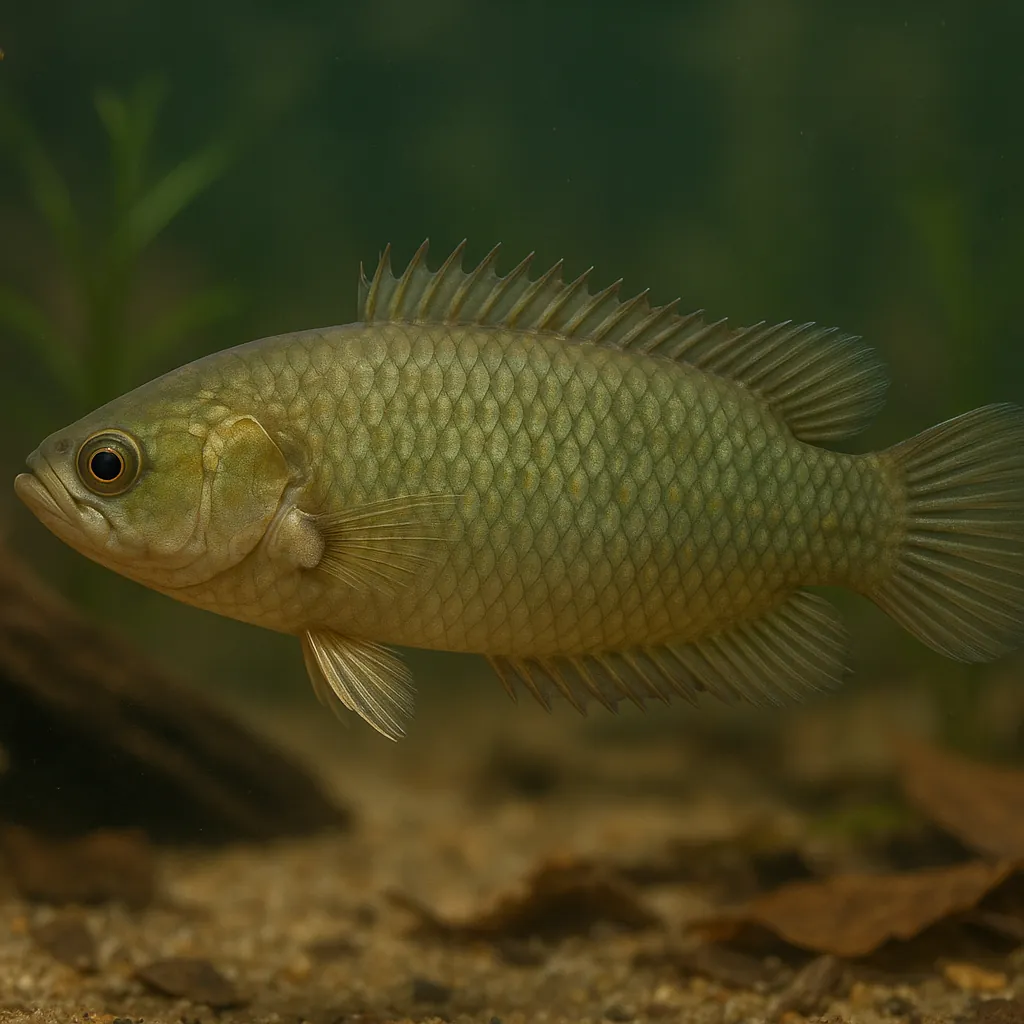
Climbing perch
Introduction
The Climbing Perch (Anabas testudineus) is a unique freshwater fish native to South and Southeast Asia. Known for its ability to survive out of water for extended periods and even "walk" short distances on land, this species has intrigued aquarists worldwide. While its coloration is relatively subdued, the Climbing Perch's fascinating behaviors and hardy nature make it an appealing choice for those seeking an unconventional addition to their aquarium. However, due to its specific care requirements and potential aggression, it is best suited for intermediate fishkeepers.
What makes the Climbing Perch unique among aquarium fish?
The Climbing Perch possesses a labyrinth organ, allowing it to breathe atmospheric air, enabling survival in low-oxygen environments and brief excursions on land.
Is the Climbing Perch suitable for beginners?
Due to its size, predatory nature, and specific care needs, the Climbing Perch is more appropriate for aquarists with some experience.
Can the Climbing Perch coexist with other fish species?
While possible, careful selection of tank mates is essential, as the Climbing Perch may prey on smaller or more passive fish.
Care and Environment
Proper care of the Climbing Perch involves attention to tank size, water parameters, filtration, and diet. A minimum tank size of 150 liters is recommended for a single fish, with larger tanks (200 liters or more) preferred for multiple individuals. Water temperature should be maintained between 22–30°C, with a pH range of 5.5–8.0 and water hardness between 5–19°N (89.29–339.29 ppm).
Efficient filtration is crucial, as Climbing Perch produce significant waste. However, strong water currents should be avoided, as they prefer calmer waters. Lighting can be dim, but they adapt to brighter conditions if provided with ample plant cover. A soft, sandy substrate is ideal, complemented by driftwood, roots, and floating vegetation to mimic their natural habitat.
Diet should be varied, including high-quality pellets, live or frozen foods like earthworms and bloodworms, and occasional vegetable matter such as lettuce or spinach. This variety ensures optimal health and coloration.
How often should I feed my Climbing Perch?
Feeding once or twice daily with a mix of protein-rich and plant-based foods is recommended.
Do Climbing Perch require a specific type of filtration system?
A robust filtration system is necessary to handle their waste production, but ensure it doesn't create strong currents.
Can I keep live plants with Climbing Perch?
Yes, but opt for hardy species like Java fern, as they may nibble on softer plants.
Origin and Habitat
The Climbing Perch is native to South and Southeast Asia, including countries like India, Sri Lanka, and China. They inhabit a variety of freshwater environments such as small streams, ponds, and occasionally brackish waters. These habitats are often characterized by slow-moving or stagnant waters with abundant vegetation and soft substrates. Their adaptability allows them to thrive in diverse conditions, including areas with low oxygen levels, thanks to their labyrinth organ.
What types of environments do Climbing Perch prefer?
They favor slow-moving or stagnant freshwater bodies with ample vegetation and soft substrates.
Can Climbing Perch survive in brackish water?
While they can tolerate brackish conditions, they thrive best in freshwater environments.
How do Climbing Perch adapt to low-oxygen habitats?
Their labyrinth organ enables them to breathe atmospheric air, allowing survival in oxygen-depleted waters.
Temperament and Compatibility
Climbing Perch exhibit varying degrees of aggression, with some individuals being relatively peaceful and others more territorial. They are predatory and may consume smaller fish that fit into their mouths. Therefore, it's advisable to house them with similarly sized, robust species such as larger cichlids or catfish. Providing ample space and hiding spots can help mitigate aggressive behaviors.
Are Climbing Perch suitable for community tanks?
Due to their predatory nature, they are best kept with similarly sized, robust tank mates.
Do Climbing Perch need to be kept in groups?
They can be kept singly or in groups if the tank is spacious enough to prevent territorial disputes.
How can I reduce aggression in Climbing Perch?
Providing a large tank with plenty of hiding spots and visual barriers can help minimize aggression.
Interesting Facts
The Climbing Perch's name stems from myths suggesting it can climb trees; however, this is a misconception. In reality, they can "walk" short distances on land by using their gill covers and pectoral fins to move between water bodies. This adaptation allows them to survive in fluctuating environments and colonize new habitats. Additionally, their ability to breathe atmospheric air enables them to endure in oxygen-deprived waters where other fish might not survive.
Can Climbing Perch actually climb trees?
No, they cannot climb trees; the name is based on a myth.
How do Climbing Perch move on land?
They use their gill covers and pectoral fins to "walk" short distances between water bodies.
Why are Climbing Perch considered hardy fish?
Their ability to breathe air and tolerate various water conditions makes them exceptionally resilient.
Sources
All information in this article has been gathered from the following reputable sources:
Overview
Recommended Tank Size 52.8 Gallons (for multiple individuals) |
Minimum Group Size 1 |
Minimum Tank Volume 39.6 Gallons |
Maximum Adult Length 9.8 inches |
Average Adult Length 6.7 inches |
Shoaling (6+ required) No |
Preferred Water Type Freshwater |
Temperature Range (°C) 22–30 |
pH Range 5.5–8.0 |
Water Hardness (dGH) 5–19 |
Typical Lifespan (years) 5 years |